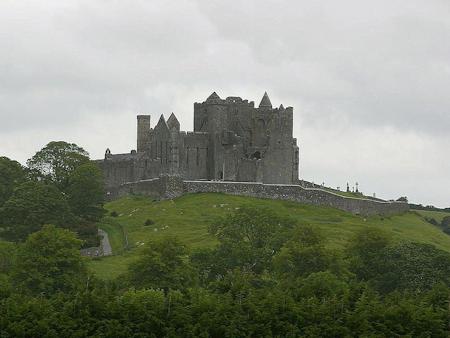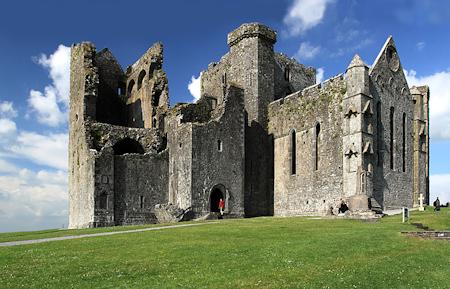
Cashel Castle
The 11th Century castle at the Rock of Cashel was donated to the church in the 12th Century. The church added a cathedral to the site in the 13th Century. Today the castle is a combination of fortress and cathedral and has been described as a remarkable collection of Celtic art and medieval architecture.
The First Fortifications
There have been fortifications at the Rock since the 4th Century when Cormac, a king of Munster, built his seat here and it subsequently became the seat for the Kings of Munster. It's easy to see why. The land around the castle is fertile and mostly flat. The Rock of Cashel rises 30 metres above the plain making it highly visible and very defensible.
St Patrick visited the Rock in 448 where he converted King Oengus mac Nad Froich to Christianity. The Rock of Cashel became an important Christian site and the Kings of Munster gave financial assistance to the early church. St Patrick's visit also brought the rock its other name – St Patrick's Rock.
It is thought that Brian Boru, crowned the first High King of Ireland in 997, had his seat here too.
The early history of the castle is quite unclear. The earliest building on the site is the Round Tower which has been dated to around 1100. It stands 28 metres high and is still the tallest structure at the castle.
In 1101 Cashel Castle was gifted to the Church of Ireland by Muirchertach Ua Briain.
Construction started on Cormac's Chapel in 1127 and it was consecrated in 1134. The chapel is a Romanesque church, but with strong Germanic influences. Inside, it has a barrel-vaulted roof and one of the best-preserved 12th Century Irish frescos.
The Cathedral
There have been two cathedrals built on the Rock of Cashel. Work on the first adjoining cathedral began in 1169, but by the middle of the 13th Century it had been completely replaced by the second.
The cathedral has an aisleless cruciform plan. It was originally intended to be longer, but modifications in the 15th Century saw it closed off by a high residential tower house.
It is thought that Richard O'Hedigan, Archbishop from 1406 to 1440 was responsible for the tower house. He was also responsible for the construction of the Hall of the Vicars Choral on the south side of the close.
The cathedral and castle had survived quite a few attacks over the years, but one of the most devastating occurred during the Irish Confederate Wars. In 1647 Parliamentarian troops under Murrough O'Brien, 1st Earl of Inchiquin sacked the castle and the town. In what later became known as the Massacre of Cashel over 1,000 people were killed. Many had taken shelter at the Rock of Cashel, but very few townsfolk were spared and the garrison was killed. The chapel and cathedral were plundered and there were numerous acts of iconoclasm with works of religious art being defaced or smashed.
By the 18th Century the castle and cathedral were falling into disuse. The cathedral moved into the town and the roof was removed.
The castle came into state care in 1869 and conservation work was carried out in the late 19th Century. Today the castle and cathedral are under the care of the Office of Public Works and the Rock of Cashel is one of Ireland's most popular tourist attractions.
Facilities available at the Rock include exhibitions on the castle's history, public toilets and car parking nearby. Guided tours of the site are available as well as a guide book printed in a number of languages.
Status: Heritage Site / Visitor Attraction
Owner: Government of Ireland
Tel: +353 62 61437
Email: rockofcashel@opw.ie
Website: www.heritageireland.ie
Opening Times: Mid September to Mid October Daily 9am-5.30pm / Mid October to Mid March Daily 9am-4.30pm / Mid March to Early June Daily 9am-5.30pm / Early June to Mid September Daily 9am-7pm


View of the Rock of Cashel from a distance

The cathedral with the castle buildings behind